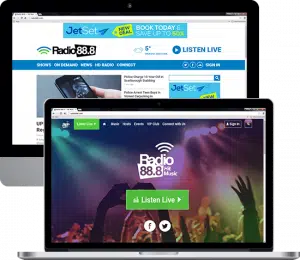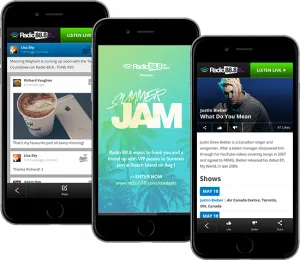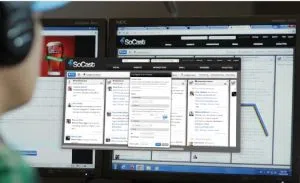In recent years, radio audiences have been heading more towards digital channels. As evidence of this, in the first half of 2018, online music streams grew by over 118 billion. Additionally, digital revenues for radio grew 13.4% in 2017 while on-air revenues remained relatively flat.
With this in mind, how does your radio station compete?
To keep your audience’s attention in the digital age, you need to engage them and provide them access to information and entertainment when and where they want it. The question is – how can you do this?
Here at SoCast, we’ve broken down the four key channels that you need to engage your radio listeners in digital. We’ll also provide you with some tactics you can use to connect with your audiences in these channels.
1. Website

Your radio station’s website is the bread and butter of your digital strategy. Having a great radio website allows you to deliver information to your listeners even if they miss your live broadcast.
Hosting on your website also helps you to extend the shelf life of your content. If you had a great morning show bit or interview, hosting this content on your website will allow your listeners to come back and visit it again and again.
Here are some important considerations when assessing your radio station’s website:
- Ensure you are streaming your broadcast to allow listeners to tune in online
- Use a branded player that complements your website and keeps audiences engaged while listening to your stream
- Enable mobile responsiveness on your website so that your audience can easily navigate your website on their phone or tablet
It is also important to consistently post high value content on your website. Having more high value content will allow you to rank higher in search engines and will help your website become a trusted source of local news. At SoCast, we suggest uploading new content to your website at least 10x per day.
By following these strategies, you will be able to build a strong web presence that attracts a large number of visitors each month. Once you have a strong web presence, you monetize it with digital inventory. Check out this infographic to see what tactics other radio stations use to increase their digital revenues.
2. Mobile App

As a society, we have become dependent on our mobile devices. In fact, US consumers now spend 5 hours per day on mobile devices with 92% of that time spent in apps. As such, this is another channel that you need to engage your audiences in and compete for their attention.
Mobile apps allow your listeners to access your station’s content while they are on the go. By having your stream, news, blog, podcasts and other content available via your mobile app, you’ll be able to capture more of your audience’s attention.
Here are some of the key features that need to be on your radio station’s mobile app:
- Streaming so that your audience can listen to your broadcast via the app
- In-app texting to allow listeners to interact with your DJs on mobile
- Push notifications to deliver key information such as weather and traffic updates to your listeners as it happens
- An alarm clock which allows listeners to set an alarm and wake up to your morning show rather than their phone alarm
By creating a robust mobile app that includes these key features, you will be able to capture your audience’s attention while they are on the go. Having a mobile app with a strong monthly active user account also allows for additional monetization opportunities.
To learn more about how a mobile app can benefit your radio station, check out this whitepaper on that very subject!
3. Social Media

Social media is another channel where it is absolutely paramount that your radio station engages its listeners. People spend nearly two hours per day on social media, so it’s important that your radio station works to capture their attention here as well.
Fortunately, radio and social media play well together. Social media allows you to extend the power of your brand and on-air personalities. It allows you to create more of a community around your station by encouraging listeners to interact with your brand online. Additionally, social can amplify the reach of your content and allows people to access it if they miss your live broadcast.
Here are some guidelines for executing a social media strategy at your radio station:
- Post content regularly so that you are consistently delivering value to your followers
- Use a tool to schedule posts so that you can queue up content throughout the day rather than having to wait to post content at the appropriate time
- Ensure posts link back to your website so that you can drive additional traffic and ad impressions
- Embed your social media feeds on your website to give your audience more opportunities to interact
- Encourage your audience to comment on your posts so that you can increase engagement and reach
- Use appropriate user tags and hashtags to capitalize on trending topics
- Utilize images and video in your posts to increase engagement
- Create a social media policy to ensure that your DJs are posting appropriate content on social media
Much like with other digital channels for radio, consistency is key in social media. By regularly applying these best practices, your radio station will be able to build a robust social media presence that serves to engage your audience and drive traffic back to your website.
4. Voice Activated Devices

Voice is a new digital channel for radio that is rapidly increasing in popularity. In fact, according to Gartner, 75% of US homes will have a smart speaker such as Google Home or Amazon Alexa by 2020. Knowing this, it is important that your radio station is able to engage listeners on these devices.
Voice activated devices give radio the opportunity to get back into the home. Very few households today own a radio. However, they can listen to your radio station via their smart speakers.
One important tactic to employ is to create an Alexa skill for your station. These skills essentially function as voice commands that will allow smart speakers to play your broadcast. You can claim a skill so that when a user says “Hey Alexa, play Station X”, the smart speaker would then play your broadcast.
These skills have limited availability, however. Each skill can only be claimed once. For instance, if there are two stations named “B101.5” – only one of them would be able to claim the skill to “play B101.5” on an Alexa via that direct command.
Voice activated devices also provide some unique advertising opportunities. Advertisers can create interactive ads that allow users to engage with commercials by voice. For instance, you could have an advertisement that announces “Say ‘I’m hungry’ for 25% off your next pizza!” When a listener replies with the prompt, they would then receive the coupon via email.
So there you have it, the four main channels that your radio station needs to participate in to engage its audiences in digital. Since there are so many different places that your listeners engage with content these days, it’s important for your radio station to play in the meaningful channels. However, it is also very important to be consistent in any channel you are active in. By doing so, you will be able to keep your audiences engaged no matter where they choose to access information and entertainment.
At SoCast, we provide a platform that helps extend your radio brands into all digital channels, simplify digital workflows, engage your audiences and grow digital revenue. To learn more about how SoCast can help you connect with your listeners in digital, speak to one of our Specialists.


Follow us on: